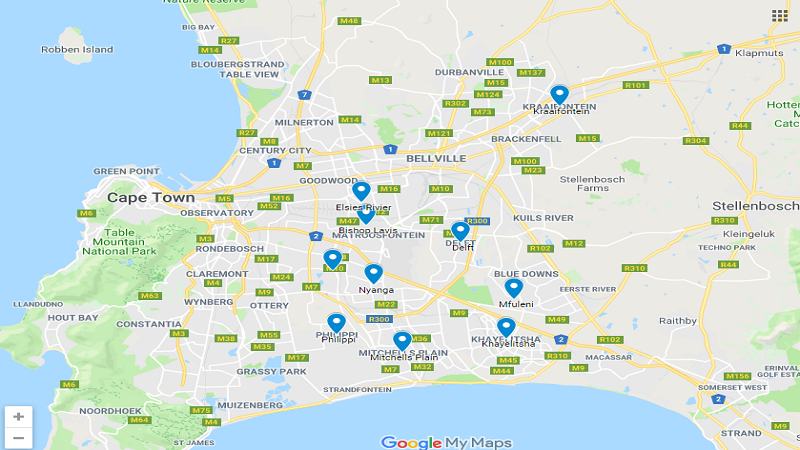It’s a network, culture and lucrative business.
And to keep profits high, Cape Town’s gangs run highly organised, militant operations where only the smartest and most strategic is given a seat at the table, former high-ranking gang member Safwaan* said.
The boys lured into gangsterism are predominantly from troubled or single-parent homes where the son is seeking a father figure or role model, he explained.
“It’s about offering a sense of belonging, a better unit than the one you know. They will promise to be your brother, father, uncle – everything in one pseudo family package. All you need is the right attitude and a strong sense of identity. Those are the ones who make the best recruits,” he said.
“Gangs don’t go after the weak. But when they are found to be in the ranks, they are the ones used as foot soldiers, the ones who are given a gun knowing that they will probably die in the first line of fire.”
Most enter the ranks as runners, with preference given to children in school uniforms because authorities are less likely to search them as they are minors.
An enforcer follows the instruction of the gang leader, specifically when it comes to carrying out hits.
Lieutenants and colonels are the “thinkers”, the brains behind the gang business.
“You, as a lay person, think this business is disorganised. That is not at all the case. Do you know gangs even have their own intelligence sector?”
Top 10 most dangerous police precincts
According to police sources linked to the Anti-Gang Unit, there are about 30 major gangs in Cape Town alone. Among the biggest groupings are the Americans, the 28s, the Mongrels, the Terrible Josters and the Junky Funky Kids.
This excludes the countless splinter groups with membership of tens to thousands, each usually associated with one of the major gangs.
It was impossible to estimate how many gangsters run the streets on the Cape Flats, one well-placed source told News24.
According to statistics, the 10 most gang-ridden precincts in Cape Town contributed to 42% of attempted murders in the province.
Members of the South African National Defence Force have been deployed for three months to assist the police in stemming the blood flow in Bishop Lavis, Mitchells Plain, Delft, Elsies River, Nyanga, Khayelitsha, Mfuleni, Philippi, Kraaifontein and Manenberg.
Troops hit the streets of the Cape Flats on Thursday, a week after Police Minister Bheki Cele announced that President Cyril Ramaphosa had given the go-ahead for soldiers to enter gang-infested areas.
Well-placed sources gave News24 an overview of who is fighting who in these 10 areas:
Detective ‘shortage’
Gang-related crime “runs rampant in the province”, Community Safety MEC Albert Fritz said this week. He argued the Western Cape did not have enough detectives to investigate the spate of criminality and gangsterism.
According to the provincial department’s report on the state of detective services in the Western Cape, 48% had a caseload of more than 200 dockets per person – 333% above the 50 to 60 case norm, Fritz said.
“There is a shortage of 548 detectives in the Western Cape and 142 posts currently remain vacant. The assessment further highlighted that there is a need to allocate an additional 443 posts to priority stations in the Western Cape. Without these detectives, conviction rates for gang-related crime will remain low.”
Many detectives did not have the adequate specialised training to investigate organised and gang-related crime, Fritz said.
“Not only are they insufficiently skilled, but their lives are equally put at risk when they are out in the field as they do not understand the dynamics at play.”
‘It’s about money, dominance’
Turf wars have been raging for decades as each gang tries to overtake the other as the most influential.
“And it’s all about money,” the police source explained. “The one with the most contraband is the most powerful. The more turf, perlemoen and guns in your corner, the richer and more dominant you become.”
Older and more established gangs are more difficult to bring to justice, while smaller gangs are less organised and more likely to be arrested.
“It’s simple: the more you’re caught, the more you learn.”
Not much has changed over the decades in terms of how these underworld groupings operate and the degree of violence used in gang-related attacks remain as brutal as it has been since the 1970s.
“Gangsterism is a culture. It will always be there. We will never stop it, but we can try to decrease it.”
According to Safwaan, in gangsterism there is usually only one way in and one way out – bloodshed.
“Most of the time, you would get killed if you try to leave. Some find a way out through religion, but you have to prove your commitment to that faith or else you can die then too,” he said.
“But the most common one is called a ‘write-off’ – it’s when you promise your son, nephew or relative to take your place. Sometimes the person offered is as young as 5, 6 years old. You hope that by the time that person is of age, the commitment would have been forgotten or the people involved would have died. But if it doesn’t work out that way, when they are old enough to be useful, they will be called on.
“As long as there is a need for a pseudo family, there will never be a shortage of members willing to join.”
*Not his real name
(Source: News 24)






 WhatsApp us
WhatsApp us 

